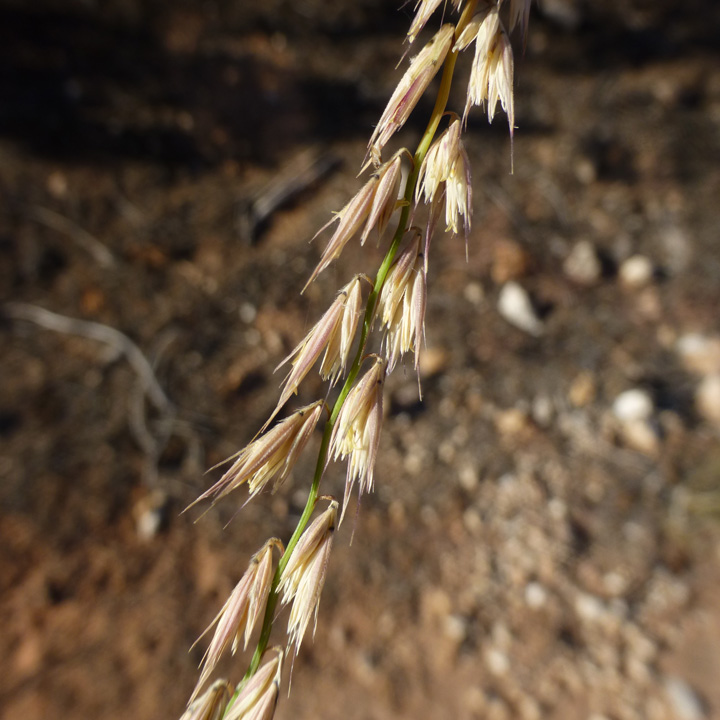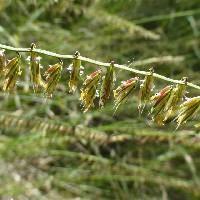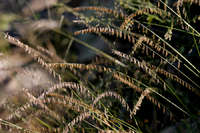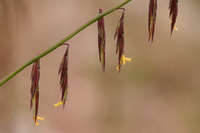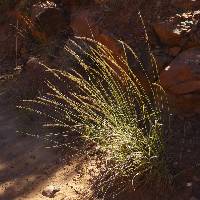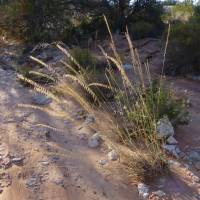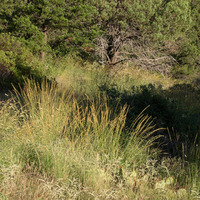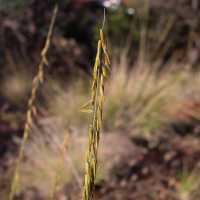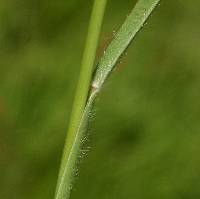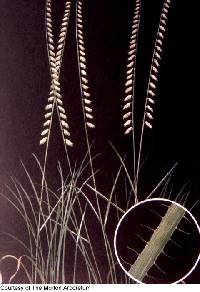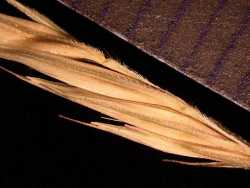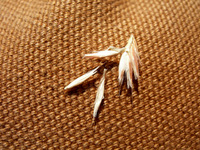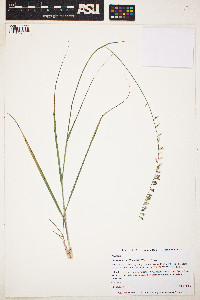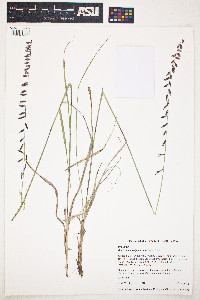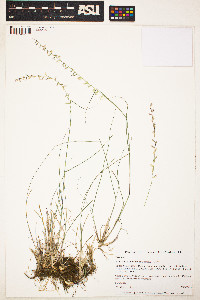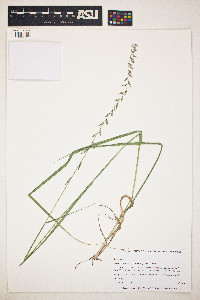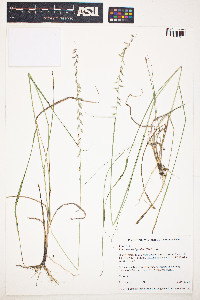|
|
|
|
Family: Poaceae
sideoats grama
[Atheropogon curtipendulus (Michx.) E.Fourn., moreChloris curtipendula Michx.] |
Plants perennial; cespitose or not, with or without rhizomes. Culms 8-80 cm, erect or decumbent, solitary or in small to large groups. Leaves evenly distributed; sheaths mostly glabrous, sometimes with hairs distally; ligules 0.3-0.5 mm, membranous, ciliate; blades 2-30 cm long, (1.4)2.5-7 mm wide, at least some over 2.5 mm wide, flat or folded when dry, usually smooth abaxially and scabrous adaxially, occasionally pubescent, bases usually with papillose-based hairs on the margins. Panicles 13-30 cm, secund, with (12)30-80 reflexed branches; branches (5)10-30(40) mm, deciduous, with (1)2-7(15) spikelets, axes terminating 3-5 mm beyond the base of the terminal spikelets, apices entire; disarticulation at the base of the branches. Spikelets appressed, all alike, with 1 bisexual and 1-2 sterile, rudimentary florets. Glumes unequal, glabrous or scabrous; lower glumes 2.5-6 mm, 1/2 or more as long as the upper glumes; upper glumes 5.5-8 mm; lowest lemmas 3-6.5 mm, glabrous or scabrous-strigose, often minutely rugose, acute or inconspicuously 3-lobed, 3-veined, veins usually extending as short mucros or awns to 6 mm; central mucros or awns not flanked by membranous lobes; lowest paleas acute, unawned; anthers 1.5-3.5 mm, yellow, orange, red, or purple; distal floret(s) 0.4-3.5 mm, sterile, variable, usually a glabrous lemma having a short membranous base, no palea, and 3 unequally-developed awns, central awns 1.5-7 mm. 2n = (20), 40, 41-103. Bouteloua curtipendula is a common, often dominant or co-dominant species in open grasslands and wetlands of the drier portions of the central grasslands of North America. It ishighly regarded as a forage species and is also an attractive ornamental. Its range extends from the Flora region through Mexico and Central America to western South America. As the range of chromosome numbers suggests, B. curtipendula is an apomictic species. There are three varieties. Two of the three grow in the Flora region; the third, B. curtipendula var. tenuis, is endemic to Mexico. Perennial herb, sometimes tufted and rhizome-bearing 8 cm - 1.1 m tall Leaves: basal and along culm, with a usually hairless sheath that is sometimes hairy near the base and a membranous ligule 0.3 - 0.5 mm long and hairy along the margin. The blade is 2 - 30 cm long, 1.4 - 7 mm wide, flat (dry leaves may be folded), sometimes hairy, often smooth beneath and rough above, with the lower part usually having warty-based hairs on the margins. Inflorescence: branched (panicle), 13 - 30 cm long, with twelve to 80 reflexed branches. The branches are 0.5 - 4 cm long and extend 3 - 5 mm past the base of the uppermost spikelet. Fruit: a caryopsis. Culm: 8 cm - 0.8 m long, erect to decumbent, single or clustered. Spikelets: one to fifteen per branch, mostly arranged on one side of the axis. Glumes: unequal, single-veined, hairless or rough, with the lower glume 2.5 - 6 mm long and the upper glume 5.5 - 8 mm long. Florets: two or three per spikelet, with one bisexual and one or two poorly developed and sterile. Bisexual florets have yellow, orange, red, or purple, 1.5 - 3.5 mm long, anthers. Lemma: of bisexual floret 3 - 6.5 mm long, pointed or slightly three-lobed, three-veined, hairless or rough-appressed hairy, often minutely wrinkled, with an awn or abrupt tip (mucro) to 6 mm long. The lemma of each sterile floret is 0.4 - 3.5 mm long, hairless with a short mebranous base and three unequal awns, the central awn 1.5 - 7 mm long. Palea: pointed and awnless on bisexual floret, absent on sterile floret. Similar species: Bouteloua hirsuta and Bouteloua gracilis have fewer branches on a shorter stalk, but have many more spikelets per branch. Flowering: early July to early October Habitat and ecology: This species is characteristic of hill prairies, but also grows on dry sandy hills and slopes. Occurence in the Chicago region: native Etymology: Bouteloua is named after Spanish botanists and brothers, Claudio (1774-1842) and Esteban (1776-1813) Boutelou y Soldevilla. Curtipendula means short-hanging. Author: The Morton Arboretum Erect perennial 3-10 dm from short slender rhizomes; sheaths smooth or nearly so; ligule a band of short hairs; blades elongate, 2-7 mm wide, scabrous on the margins; spikes (10-)40-70, spreading or nodding, 8-15 mm, secund along an axis 1-3 dm, falling entire; spikelets usually 3-7; first glume linear-subulate, 3-4 mm; second glume lanceolate, 4-7 mm; fertile lemma usually somewhat exceeding the glumes, acuminate, its lateral veins prolonged into awns 1 mm; vestige with a long central awn and 2 shorter lateral ones arising below the middle, or much reduced or obsolete; 2n=20-103. Dry woods in the e. states, and dry prairies and sand-hills in the w.; Me. to Mont., s. to Ala., Calif., and C. and S. Amer. (Atheropogon c.) Ours is var. curtipendula. Gleason, Henry A. & Cronquist, Arthur J. 1991. Manual of vascular plants of northeastern United States and adjacent Canada. lxxv + 910 pp. ©The New York Botanical Garden. All rights reserved. Used by permission. FNA 2003 Common Name: sideoats grama Duration: Perennial Nativity: Native Lifeform: Graminoid General: Large, often- rhizomatous perennial grass, can be tufted or not; stems erect or decumbent, 8-100 cm, solitary or in small to large groups, elliptical-round in cross section, rarely branched; fibrous roots and long or short rhizomes. Vegetative: Blades evenly distributed along culm, flat or folded when dry, long, drooping, rough above, 2-7 mm wide, 2-30 cm long, with pustular-based hairs on margin of blade near collar; sheath with papery margin, open and rounded; ligule thin and translucent, trun Inflorescence: Panicle with 20-50 short (1-3 cm), deciduous spicate branches that hang off main inflorescence stem; branches with 2-7 short awned spikelets; spikelets with 1 perfect floret and 1 rudimentary floret; glumes unequal, lower glume half as long as upper glume, upper glume as broad and long as lemma, lemma 4-7 mm; palea slightly shorter than lemma; usually short awns on glumes and lemmas; anthers red to yellow. Ecology: Found in open grasslands, limestone outcrops, rocky slopes, woodlands and forest openings from 2,500-7,000 ft (762-2134 m); flowers June-November. Distribution: Much of N. America, especially common in the Great Plains and Southwest; from Canada south through Mexico to western S. America. Notes: Side-oats gramma is a descriptive common name due to the inflorescence which has 20-50 small branches, each with 2-7 spikelets(these can appear as clusters of spikelets at first and not branches) which dangle off of one side of the inflorescence axis. The small branches are deciduous, and leave a narrow zig-zag pattern with small nodules where they have detached. It is a perennial with leaf-blades 2-7 mm wide and flat, not rolled. This is a quite common species, being widespread and often abundant where it occurs. There are two varieties in Arizona: var. curtipendula and var. caespitosa. Var. curtipendula can be distinguished by being long-rhizomatous, with stems solitary or in small clumps. Var. caespitosa are not long-rhizomatous, though the bases are sometimes knotty with short rhizomes, and stems are in large or small clumps. A third variety, var. tenuis is endemic to Mexico, but a single collection has been made in the Huachuca Mountains. This variety does not have very long rhizomes, and has conspicuously curled blades. Ethnobotany: Tewa, Zuni and Hopi made tools such as brooms and brushes out of the stems; Hopi used the fibers for basketry; used medicinally and ceremonially by the Ramah Navajo; seeds used to make porridge and bread, and even as a cash crop by the White Mountain Apache. Etymology: Bouteloua named for brothers Claudio (1774-1842) and Esteban (1776-1813) Boutelou Agraz, Spanish botanists and horticulturalists; Curtipendula is Latin for shortened hanging pendant. Synonyms: None Editor: SBuckley 2010, FSCoburn, AHazelton 2015 |
|
|
|


